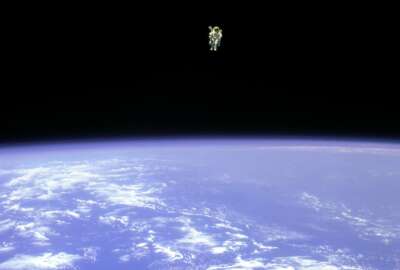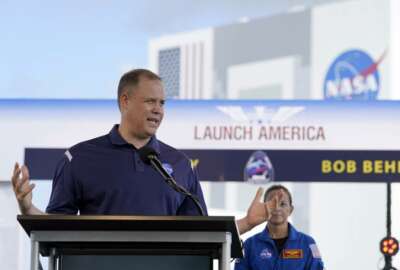

NASA and the Agriculture Department have inked an agreement to deepen cooperative efforts in research on agricultural production, conservation and food security.
Best listening experience is on Chrome, Firefox or Safari. Subscribe to Federal Drive’s daily audio interviews on Apple Podcasts or PodcastOne.
NASA looks down from space. Farmers grow things upward from the earth. Now NASA and the Agriculture Department have inked an agreement to deepen cooperative efforts in research on agricultural production, conservation and food security. With details, NASA’s acting associate administrator for international and interagency relations, Mike Gold, spoke with Federal Drive with Tom Temin.
Interview transcript:
Tom Temin: Mr. Gold. Good to have you on.
Mike Gold: Thank you. It’s a pleasure to be here, especially talk about this vital topic.
Tom Temin: Well, food matters, space matters and they’re all kind of connected, I guess, with an atmosphere in between. Tell us what this agreement is all about?
Mike Gold: Certainly. So I’d almost like to say we have an A in NASA for aeronautics, but it can also be for agriculture, that NASA has a long standing relationship with the USDA. And we’re proceeding right now with the Artemis program with the goal of putting the first woman and the next man on the moon, and establishing a permanent presence on the moon and going on to Mars. And unless we can create new innovations in agriculture and food development, we’re not going to be able to execute that mission. So the relationship with USDA and innovations in agriculture is incredibly important for NASA’s exploration mission, as well as dramatically improving the quality of life here on Earth.
Tom Temin: Well, it sounds like you’re looking into ways to grow things on the moon, but that couldn’t be right.
Mike Gold: Well, it’s certainly, I think, at least partially right. We need to learn how to effectively grow food on not only the moon, but on the way to the moon, and on Mars. Again, we all love the Apollo program, but the Apollo program had a flaw in that it ended. And now wonder Artemis, we need to return to the moon and do so on a permanent basis. And to get back to your question, if we’re going to do that we have to learn how to cultivate agriculture on the moon, which is a very difficult place to do so. But if we can learn how to conduct agriculture effectively on the moon, not only will it enable our exploration programs, we will have new innovations, technology systems and wisdom that we can apply here on Earth to increase crop yields and stop famine and feed the world.
Tom Temin: And what assets can NASA bring to this question. That is to say, right now everything we know about growing is conducted on the ground and NASA has been able to make a series of satellite images over the decades showing yields and different conditions of crop lands as they are seen from space. What’s next here in the research piece?
Mike Gold: So we have some amazing assets to be able to bring to bear. But probably the most unique and singular is the International Space Station. The ISS provides a laboratory for experimentation in agriculture that is simply unparalleled. Microgravity, everything reacts differently within that environment, particularly plants and plant growth, etc. Which is why we can learn new aspects of agriculture, of plant growth, of plant reactions that you simply can’t do on the ground. Examples of this include learning about the carbon cycle, soil moisture, freezing and thawing micro-green plants that we’re developing with high nutritional levels. My favorite though is we’re running electrical pulses on leafs that you can tell them how thirsty the leaf is, allowing a plant to literally text the farmers and say if they need more water. It’s these kinds of unique activities on the ISS that will be incredible for benefiting agriculture, to say nothing of our Earth observation satellites, which, as you mentioned, play a vital role already in agriculture.
Tom Temin: And that idea, say to build on that one detail of a plant being able to signal in some way that is ready for water — I imagine that has huge implications for water conservation as they get more and more fine grained in irrigation.
Mike Gold: Absolutely. Through these activities, we’re not only going to increase crop yields, the quality of the plants, but assist the environment that so much of what we’re doing relates to water management, which again is already vital, but is only going to become more so in the future. And as we develop more targeted agricultural activities, understand how water can be used judiciously to be able to get the best crop yields, the best results, we need that not only in space and on Earth, but it’s incredible synergy that we and the USDA are driving in this MOUs, the very manifestation of that partnership.
Tom Temin: And just one more technical point, I guess if you’re growing things in micro gravity or zero gravity, who says an ear of corn has to grow up, right, I guess it can grow upside down, or whichever way the light is.
Mike Gold: Absolutely. And what color that light should be, how much light the plant should receive, the impact of different lighting. All of these variables can be experimented with and learned from on the International Space Station. And again, the plants themselves react differently, and we’re actually going to learn things about plant physiology and plant growth that we don’t know now that can be applied in ways that frankly, we’re not even going to be able to imagine, but I guarantee will have a dramatic impact in agriculture and water utilization in the future.
Tom Temin: Well, I might be able to help I have a cactus growing in my studio, which is a windowless room that was only led types of fluorescent lights. And in one year with no sunlight, that cactus has doubled in size. So maybe I can help out the Agriculture Department and NASA on at least succulent growth. But let me ask you this, you have a memorandum of understanding what will happen to operationalize it? Will there be people devoted to this effort from both departments, from both agencies specifically or how does this all work in a practical sense?
Mike Gold: So the MOU articulates the specific projects and areas that we’re going to tackle, both in the near and long term at NASA and USDA, and it’s very helpful just to know, where we’re headed, why we’re doing it, etc, and to have a document like that, that we can refer back to to make sure that we’re accomplishing everything that we laid out. And there are absolutely large groups of scientists and researchers, both at NASA and the USDA that are tackling these issues and will continue to take them on. And just relative to your cactus, let me say that’s absolutely a terrific experiment with the lighting. We’re doing something similar, but we’re doing it with radishes on the International Space Station, because they do taste slightly better than cactuses.
Tom Temin: Yes, even though they’re called succulents, I don’t think they’re very good to eat the cactuses?
Mike Gold: No, it’s a bit of a misleading name, isn’t it?
Tom Temin: And there’s going to be a change in leadership probably at NASA and at Agriculture very shortly, will this memorandum of understanding, it sounds like it’s at a level that it will continue because it doesn’t sound particularly political.
Mike Gold: No. Any political party supports eating food, it’s very important. And the desire to enhance agriculture, to look at water utilization, is completely bipartisan. So while yes, we’re looking at shifts in leadership, it should have no impact on the activities that we’re conducting since, generally, everyone supports innovations in agriculture, food safety and water utilization. So we are not expecting any problems there. Everyone likes to eat.
Tom Temin: Right. And a final question, you mentioned experiments that can happen on the space station. Do you envision or does NASA envision maybe on the Artemis missions, is there capacity inside the capsule to maybe try some agricultural experiments on those missions?
Mike Gold: Yeah, absolutely. As we move forward with Artemis, agricultural experimentation, I believe, will be a large part of what we’re doing. And even if we’re taking more of almost a camping paradigm initially, as I mentioned, creating a permanent presence on the moon is a vital goal of Artemis, and agriculture will allow us to achieve that objective. So certainly, the experiments that we’re doing now on the International Space Station are intended to feed forward to inform future experiments and technologies that we will use on the moon, and then eventually on Mars, where it will be even more important.
Tom Temin: I guess this could give all new meaning to moon pies and Mars bars.
Mike Gold: Now you’re just making me hungry.
Tom Temin: Alright. Mike Gold is Associate Administrator for International and Interagency Relations at NASA. Thanks so much for joining me.
Mike Gold: Thank you for the time.
Copyright © 2025 Federal News Network. All rights reserved. This website is not intended for users located within the European Economic Area.
Tom Temin is host of the Federal Drive and has been providing insight on federal technology and management issues for more than 30 years.
Follow @tteminWFED


